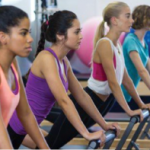First, let’s address the basic differences between the more traditional Reformer and the Megaformer. Traditionally, Reformers consisted of a simple wooden frame with legs, a moving platform or carriage with four wheels that moved along tracks lengthwise on the frame. There was a footbar at one end, which had two positions—up and down—and a gear bar with four attachments for four springs mounted under the carriage to provide various levels of resistance. The padded carriage also had padded shoulder blocks on the far end, opposite the footbar. There was also a headrest that typically had two positions (again, up/down).
Why do Comprehensively Trained Pilates Teachers Seem to Dislike The Megaformer? How is it Different Than Other More “Accepted” Reformers? Photo Gallery
Nearby, there were leather straps, which were threaded through large pulleys inside the far end of the frame. The straps had an unadjustable loop at the opposite end, which had a D ring attached to a set of handles. The apparatus were made by hand in small shops. Throughout the years updates by various Pilates equipment manufacturers have been added to the Reformer and other pieces of equipment, including: the addition of a fifth spring; various gear and footbar positions; a more adjustable headrest; and variations on the leather straps.
Megaformers, on the other hand, are made of metal and typically much larger than a traditional Reformer. There is a platform, as well as sets of handles and footbars on each end. The front of the Reformer has a set of bungee cords. There are also two sets of cables/ropes and and handles. The carriage itself is not just a simple rectangle; it’s inverted, rounded shape featuring various markings and numbers used for positioning the exercises.
The carriage has eight springs that can be utilized from both ends of the apparatus. Some models also have a hydraulic lift, which raises one end of the apparatus by 15 degrees. These apparatus are made in factories overseas. Some instructors feel strongly that Pilates should only be practiced on the more traditional pieces of equipment and in a specific historical sequence, as taught my Mr. Pilates himself and the teachers he trained.
There are many that still debate what that actual sequence should be; others feel that the more modern innovations on the traditional Reformer are acceptable and part of the evolution of many things, including the changing shape of the human body. In my opinion, the reason many instructors don’t like the Megaformer is based on what it represents. To many, these modern innovations are disrespectful to the Pilates philosophy.
Megaformers are viewed as part of the “fitness evolution” of modern Pilates. This evolution has significantly altered much of historical Pilates, distancing it from the method’s primary intent. Furthermore, Megaformer classes are taught in choreographed routines to loud music and organized in intervals or sets—none of which were ever considered by many to actually be “Pilates.” We do know a few things: Joe never taught Pilates as interval training; he never taught sets of exercises or many repetitions of any of the exercises; and he did not use loud music because he wanted his students to focus on their bodies and what they were doing.
Exactly what Joe would have thought about all of this, well, that’s hard to say. Perhaps by focusing and applying the guiding principles of Pilates, we can move forward—no matter what we call the Reformer we teach upon.


